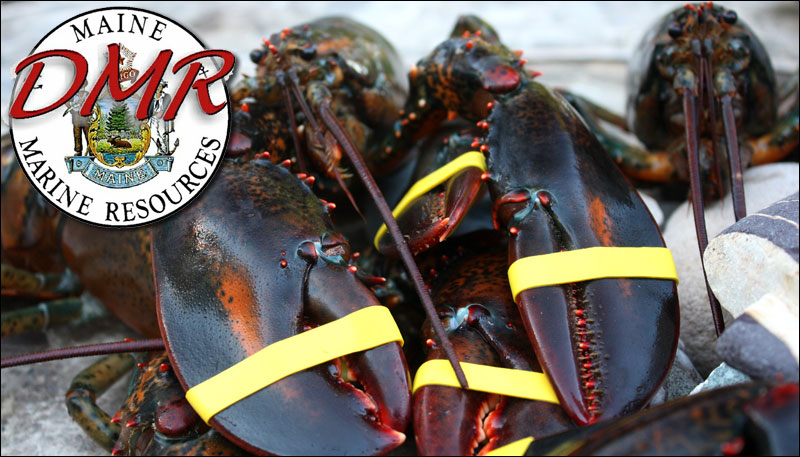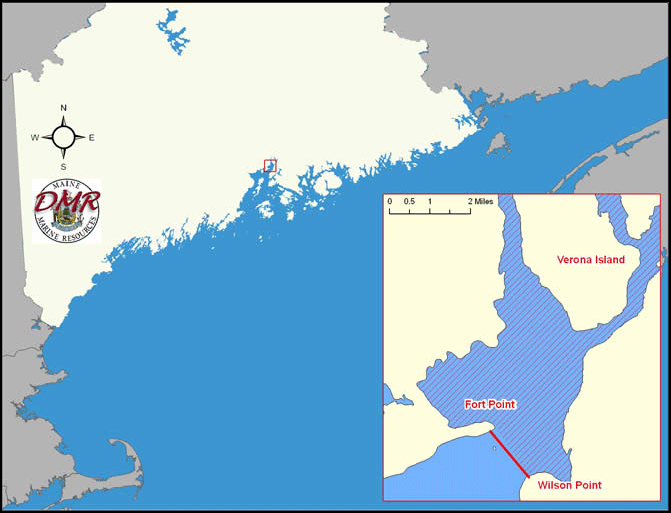Mercury contamination closes northern portion of Penobscot River to lobster and crab fishing
 The affected area is approximately 7 square miles, out of more than 14,000 square miles in the Gulf of Maine where lobsters are harvested. (Photo by Holly S. Edwards)
The affected area is approximately 7 square miles, out of more than 14,000 square miles in the Gulf of Maine where lobsters are harvested. (Photo by Holly S. Edwards)
 The DMR’s two-year Penobscot River Area Closure extends from Fort Point in Stockton Springs to Wilson Point in Castine, and north up the river. (Courtesy Maine Department of Marine Resources)
The DMR’s two-year Penobscot River Area Closure extends from Fort Point in Stockton Springs to Wilson Point in Castine, and north up the river. (Courtesy Maine Department of Marine Resources)
 The affected area is approximately 7 square miles, out of more than 14,000 square miles in the Gulf of Maine where lobsters are harvested. (Photo by Holly S. Edwards)
The affected area is approximately 7 square miles, out of more than 14,000 square miles in the Gulf of Maine where lobsters are harvested. (Photo by Holly S. Edwards)
 The DMR’s two-year Penobscot River Area Closure extends from Fort Point in Stockton Springs to Wilson Point in Castine, and north up the river. (Courtesy Maine Department of Marine Resources)
The DMR’s two-year Penobscot River Area Closure extends from Fort Point in Stockton Springs to Wilson Point in Castine, and north up the river. (Courtesy Maine Department of Marine Resources)
AUGUSTA — The Maine Department of Marine Resources Tuesday announced a limited closure for crab and lobster harvesters beginning at the mouth of the Penobscot River effective Feb. 22.
The closure will be in effect for a minimum of two years, and extend from Fort Point in Stockton Springs to Wilson Point in Castine and go north into the river, according to the notice.
"This closure is being taken as a precautionary measure in response to information the Department of Marine Resources recently received about mercury contamination in muscle tissue from lobsters found in this area," said DMR Commissioner Patrick Keliher in the notice.
The DMR opted to implement the closure this week after learning in November about the mercury contamination, information that was gleaned from a federal court-ordered study. Following up on that information, the DMR said it asked state toxicologist Dr. Andrew Smith, from the Maine Center for Disease Control and Prevention, to analyze the study's data.
The DMR then took the original study and Smith's analysis under advisement, according to the notice, and ultimately opted to implement the closure "to ensure that no lobsters from this area make it into the marketplace."
"Closing this small portion of the fishery was a smart and responsible move by the state," said Maine People's Alliance Executive Director Jesse Graham Tuesday night in a press release. "We need to protect local residents from harmful contamination and also ensure the ongoing health and vitality of Maine's iconic lobster industry."
The affected area is approximately 7 square miles, out of more than 14,000 square miles in the Gulf of Maine where lobsters are harvested.
The DMR said that crabs were being included in the closure due to a lack of data on crabs in the study, and because there is adequate reason to be concerned that crabs would have similar contamination levels to lobster. Because of the lack of crab contamination data, the DMR said it is being precautionary and including them until additional samples can be taken and analyzed.
"We chose to close this small area to harvesting for both commercial and recreational fishermen as a precautionary approach that protects public health and ensures consumer confidence that eating Maine lobster is safe and healthy while we conduct our own monitoring effort that will build on these new data," said Keliher.
According to the DMR, the U.S. Environmental Protection Agency monitors contaminants in Maine lobster as part of its National Coastal Condition Assessment Program. The EPA last assesses contaminants in lobster in 2010, and data from the 2010 NCCA showed that mercury levels were below the Maine CDC action limit that would warrant a consumption advisory for sensitive populations.
However, following a review by Smith and DEP staff of data recently collected as a result of a court-ordered study stemming from the Maine People's Alliance and the Natural Resources Defense Council vs. Mallinckrodt Inc. lawsuit, the DMR determined immediate action was warranted as a precautionary measure. That lawsuit found that the HoltraChem chemical processing plant deposited mercury in the Penobscot River and that a former owner of the plant, Mallinckrodt US LLC, was liable for polluting the river.
According to the Maine People's Alliance press release Tuesday night, Mallinckrodt continues to contest its role in a clean-up, and that a new trial will begin May 7 to determine whether the court will adopt the recommendation that active clean-up of the river by the corporation be pursued.
"A multi-billion dollar corporation caused this pollution and, decades later, still refuses to right that wrong," said Graham in the release. "We can't let Mallinckrodt continue shirk its responsibility. They made this mess and they need to clean it up. Maine residents and lobstermen deserve better."
The DMR is telling the public that lobsters from within the closed area are still safe to eat, but that the state toxicologist advises that sensitive populations limit their consumption of lobsters from the closure area.
Maine Marine Patrol will be working with harvesters to ensure all gear is removed from the affected areas as soon as possible. Because of the time of year, the DMR said there is very limited commercial harvesting of any species in the mouth of the Penobscot River, as most local commercial harvesters have either stopped for the season or moved operations down the bay.
"The Department has begun to reach out to harvesters and dealers to discuss the closure and plans for on-going monitoring," said the DRM in the notice.
Various state agencies will be working together over the next two years to conduct seasonal monitoring of mercury levels in lobsters and crabs, in and near the closed area.
"The monitoring will be conducted in and adjacent to the closed area and will evaluate the accumulation of contaminants," said Keliher. "We will decide, after two years, whether or not to re-open the area or to continue the closure."
"Maine lobster is the best in the world and we're taking very precautious steps to protect this valuable, unique resource and to assure consumers that they can continue to be confident that our lobsters are safe and healthy to eat," said Keliher.
Related link:
• DMR: Penobscot River Area Closure FAQ
Editorial Director Holly S. Edwards can be reached at hollyedwards@penbaypilot.com or 706-6655.
Event Date
Address
Fort Point Lighthouse
Stockton Springs, ME
United States


























